When do smoke detectors, heat detectors, HVAC vents, and other nonstructural items block fire sprinkler heads?
Customers sometimes ask us questions about system designs and fire code violations, and we recently received a very good one. It’s an interesting question because the NFPA 13 rules on fire sprinkler obstructions aren’t always clear.
An inspector cited the individual’s hospital for smoke detectors blocking fire sprinklers; objects can’t obstruct sprinklers’ spray patterns or prevent water from hitting the target area. This is why NFPA 13: Standard for the Installation of Sprinkler Systems has many sections devoted to avoiding obstructions during system design and installation.
If NFPA 13 is followed closely, you should not get dinged for obstructions unless:
- There’s been a remodel or other change in fixed objects
- The culprit is storage or other transitory objects (a common situation)
In the case we mentioned, according to the inspector, nearby smoke alarms obstructed the sprinklers:
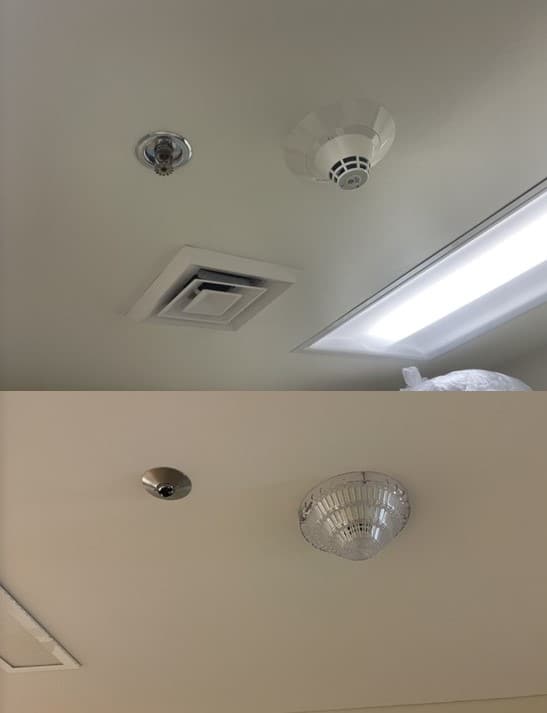
This scenario is interesting for a few reasons. First, one would assume fire alarm and fire sprinkler installers and designers would know not to place equipment like this if doing so would block spray patterns. Second, NFPA 13 doesn’t specifically mention all object types that could be obstructions, though it has various rules that apply to them.
Read on for a review of NFPA standards and obstructions—focusing on nonstructural objects— and a hypothetical analysis of the specific situation in a hospital. This blog focuses on standard spray pendent and upright sprinklers, though other rules apply to different sprinkler varieties.
Feel free to jump to sections in this table of contents:
- How sprinklers work and fire sprinkler obstruction types
- NFPA 13’s basic approach to obstructions and why the rules matter
- A good place to start: “the three-times rule”
- Spraying water under obstructions using “the beam rule”
- Fire sprinkler obstructions against walls
- Fire sprinkler head obstructions in hallways
- Handling bigger obstructions
- Ceiling fans
- A step-by-step approach to the example: hospital smoke detectors & fire sprinkler head obstructions
For more fire protection information, check out the rest of our blog, including detailed entries on obstructions for standard coverage sprinklers and obstructions for extended coverage sprinklers.
If you’re shopping for fire protection products, check out our huge selection of fire sprinkler system components. You can also use the QRFS Quick Finder to identify the specific sprinklers, fire sprinkler covers, sprinkler escutcheons, fire sprinkler heads, or sprinkler head wrenches you need.
How sprinklers work and fire sprinkler obstruction types
To understand obstructions, we must first review how sprinklers work. Their job is to wet surfaces (especially walls and floors) in their design (coverage) area, and most do it by spraying water in a roughly umbrella-shaped pattern.
An obstruction is anything that blocks the spray from a sprinkler—disrupting the spray pattern from developing, preventing water from reaching the hazard, or both.
NFPA standards recognize two general groups of obstructions based on their impact, plus several different types:
General Obstruction Groups Based on Their Impact
1. Obstructions that affect spray pattern development, typically items within 18” vertically of the deflector.
NFPA 13 (2022 edition) addresses these issues generally in section “9.5.5.2* Obstructions to Sprinkler Discharge Pattern Development” and lists the specific rules for standard spray pendent and upright sprinklers in “10.2.7.2* Obstructions to Sprinkler Discharge Pattern Development.”
2. Obstructions that affect water’s ability to reach a hazard, typically involving the “wide obstruction” rules mentioned later in this blog.
NFPA 13 generally addresses these issues in section “9.5.5.3* Obstructions that Prevent Sprinkler Discharge from Reaching Hazard” and lists the specific rules for standard spray pendent and upright sprinklers in “10.2.7.4* Obstructions that Prevent Sprinkler Discharge from Reaching Hazard.”
Types of Obstructions
- Obstructed construction (3.3.139) refers to exposed structural members (beams, trusses, rafters, etc.) that block water spray or heat distribution. NFPA 13 dedicates special sections (10.2.6.1.2) to the arrangement of sprinkler heads in obstructed construction.
- A noncontinuous obstruction (3.3.140) affects water spray from one sprinkler only. This could be a small object like a light fixture or smoke detector.
- The above item contrasts with continuous obstructions (3.3.140.1), such as soffits, beams, or ducts, which block water spray from two or more adjacent sprinklers.
- Storage is an obstruction category covered more in-depth by NFPA 25: Standard for the Inspection, Testing, and Maintenance of Water-Based Fire Protection Systems. The basic concept involves keeping boxes, pallets, or other stacked storage sufficiently far from sprinkler heads. The standard minimum clearance required is 18 inches (NFPA 25, 2023: 5.2.1.2.1), though different situations call for more room.
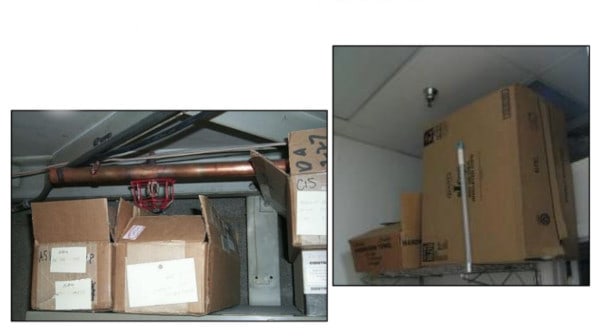
But nowhere does NFPA 13 make explicit exceptions for specific small objects or spell out all the possibilities—not even for standard fire protection equipment like smoke alarms. Nevertheless, the “noncontinuous obstruction” category means these objects can certainly be obstructions.
Fortunately, NFPA 13 provides many avenues for arranging sprinklers (or perhaps, better yet, their obstructions) to prevent issues.
NFPA 13’s basic approach to obstructions & why it’s important
NFPA 13 sums up the overall approach to obstructions in sections “9.1* Basic Requirements [for sprinkler location]” and “9.5.5 Obstructions to Sprinkler Discharge.” Here are some relevant subsections (emphasis added):
From the 2022 edition of NFPA 13
9.1.1* The requirements for spacing, location, and position of sprinklers shall be based on the following principles: […]
(3)* Sprinklers shall be positioned and located so as to provide satisfactory performance with respect to activation time and distribution.
9.5.5.1* Performance Objective.
Sprinklers shall be located so as to minimize obstructions to discharge as defined in 9.5.5.2 and 9.5.5.3, or additional sprinklers shall be provided to ensure adequate coverage of the hazard. (See Figure A.9.5.5.1.)
The language may be a little complex, but the message is simple: either sprinklers should be placed so they don’t materially affect sprinkler spray and coverage, or you need additional heads to work around any obstructions. NFPA 13 doesn’t expect perfect coverage, however. For example, the standard acknowledges and allows for “small shadowed areas” (A.9.1.1(3)). But any impacts on performance must be minimal—the sprinkler’s performance must always be “satisfactory.”
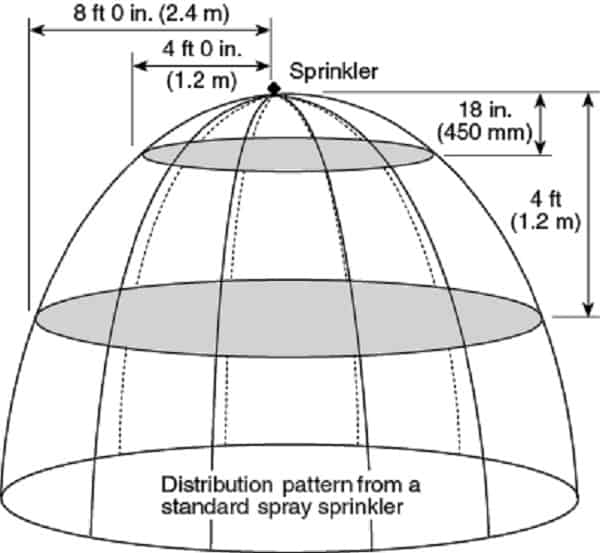
So, it might be helpful for building owners and any design professionals in charge to prioritize solutions in terms of positioning obstructions instead of sprinklers. The reasoning: if an inspector regards anything as a violation, it’s easier to move something like a smoke detector (even if it’s hard-wired) than a sprinkler connected to fixed supply pipes.
Nevertheless, that approach is debated in the fire protection field. For example, sprinkler contractors would undoubtedly agree with prioritizing sprinkler placement, but other building trade members would wholeheartedly disagree—everyone thinks their stuff is more important!
Exactly how the design, placement, and evasion of obstructions work depends on the type of sprinkler—standard coverage, extended coverage, residential, storage-focused models, etc. Again, the remainder of this article focuses on standard coverage sprinklers detailed in chapter 10 of NFPA 13. And to further simplify things, we’ll only look at upright and pendent sprinklers.
The rules for sidewall sprinklers are conceptually similar, however, and you can read them in our previous article.
A good place to start: “the three times rule”
Many fire protection pros know the “three-times rule” articulated in section 10.2.7.3.1.3 of NFPA 13 (2022 edition). The gist is that sprinklers should be spaced away from an obstruction at a distance at least three times the object’s maximum dimension (its height or width, whichever is greater)—up to 24 inches of separation, maximum. (As long as something is further than 24 inches away, the dimensions of that object don’t matter—unless it’s a big vertical column).
The three-times rule is an important measurement to consider, and here’s a diagram illustrating the concept:
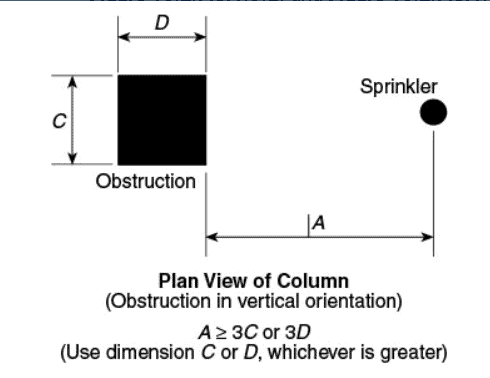
However, it isn’t always necessary to use the three-times rule. NFPA 13 intends the section to handle obstructions where water is expected to be able to throw on both sides or around an object, whether that’s a column, light fixture, or smoke detector. The rule is generally focused on ensuring the sprinkler’s spray pattern development in those upper 18 inches.
In addition, there are exceptions to having to use the three-times rule: NFPA 13 states that in light and ordinary hazard occupancies, “structural members only shall be considered” when using it (10.2.7.3.1.4)—meaning a column qualifies and not a smoke detector, for example. The standard points readers dealing with light or ordinary hazard occupancies to other rules in sections 10.2.7.2 and 10.2.7.4.2. (We’ll cover both of these scenarios below: “the beam rule” and “handling bigger obstructions,” respectively)
But note that it’s easy to misinterpret section 10.2.7.3.1.4 based on the language. The words “structural members only shall be considered” imply that you can’t apply the three-times rule to nonstructural items (like smoke detectors) in light and ordinary hazard occupancies. But in fact, you could—you just don’t have to. The NFPA 13 appendix clarifies this a bit (emphasis added):
A.10.2.7.3.1.4 It is the intent of this section to exempt nonstructural elements in light and ordinary hazard occupancies from the obstruction criteria commonly called the “Three Times Rule.”
What does that mean, practically speaking? An NFPA committee member consulted by QRFS considers the three-times rule and the beam rule (covered below) “different ways of avoiding obstructions.” So, you could conceivably follow the three-times rule for nonstructural elements in a light or ordinary hazard occupancy; you just don’t have to.
That said, other rules can also apply:
Spraying water under obstructions using “the beam rule”
If you don’t follow the three-times rules, you might use section 10.2.7.2, often called the “beam rule.”
Like the three-times rule, the beam rule primarily focuses on preserving the spray pattern vs. ensuring water can reach the hazard. The beam rule’s objective is to position sprinklers so the pattern can spray under potential obstructions, considering both the vertical and horizontal distance of the sprinkler from the object. The two basic ideas are:
- Sprinklers far away from an object (horizontally) can avoid the obstruction
- Sprinklers very close to the bottom of an object (vertically) can spray under it while being closer to it
NFPA 13 provides various scenarios for using this rule in Table 10.2.7.2(a) and Figure 10.2.7.2(a). We’ve reproduced both for you below. In short, the closer your sprinkler is to the obstruction’s side, the more level the sprinkler must be with the bottom of the object:
| Distance from Sprinklers to Side of Obstruction (A) (ft) | Maximum Allowable Distance of Deflector Above Bottom of Obstruction (B) [in.] |
|---|---|
| Less than 1′ | 0 |
| 1′ or more | 2-1⁄2″ or less |
| 1-1⁄2′ or more | 3-1⁄2″ or less |
| 2′ or more | 5-1⁄2″ or less |
| 2-1⁄2′ or more | 7-1⁄2″ or less |
| 3′ or more | 9-1⁄2″ or less |
| 3-1⁄2′ or more | 12″ or less |
| 4′ or more | 14″ or less |
| 4-1⁄2′ or more | 16-1⁄2″ or less |
| 5′ or more | 18″ or less |
| 5-1⁄2′ or more | 20″ or less |
| 6′ or more | 24″ or less |
| 6-1⁄2′ or more | 30″ or less |
| 7′ or more | 35″ or less |
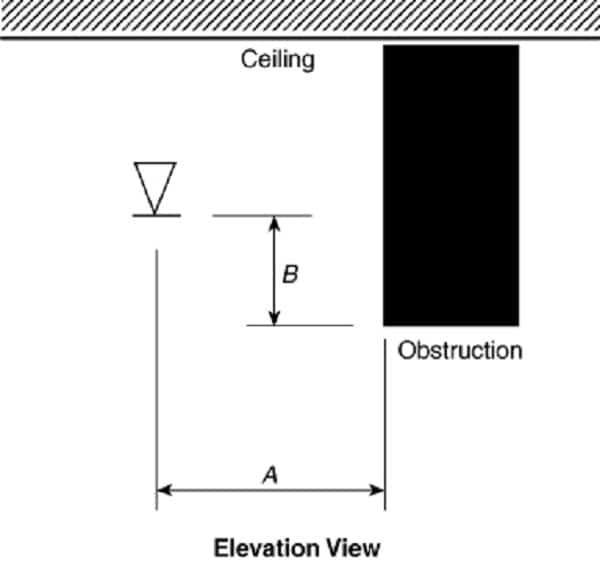
Fire sprinkler obstructions against walls
Figure/Table 10.2.7.2(a) above applies to obstructions away from walls. And there are similar but unique rules (with a more complex formula) for obstructions against walls. They are:
- If the obstruction is less than 24 inches wide, there is no limit to how close a pendent or upright sprinkler can be to it, provided other rules about sprinkler spacing from walls are followed (see this article for more info).
- If the obstruction is less than or equal to 30 inches wide, you can use a formula to determine how far away the sprinkler should be. This calculation is based on the size of the potential obstruction and the vertical distance between the item and the sprinkler.
The obstructions against walls directives are illustrated in Figures 10.2.7.2b-c:
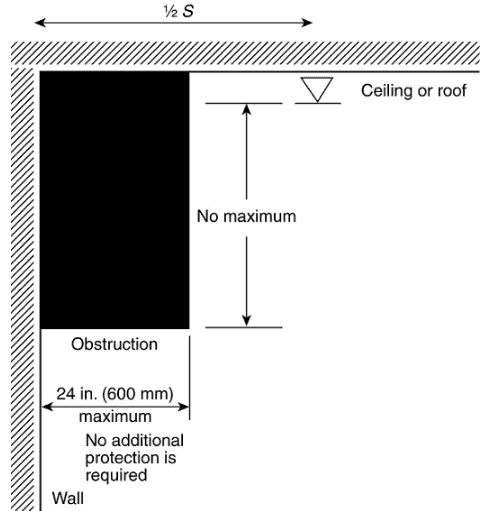
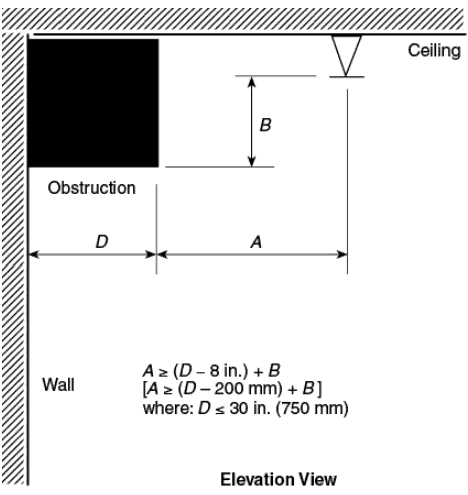
Fire sprinkler head obstructions in hallways
Hallways can be tricky environments, with little room to arrange sprinklers and plenty of small things like light fixtures and smoke detectors that get in the way. Fortunately, the fact that many hallways are smaller spaces also makes many of them easier to protect.
Per NFPA 13’s Figure 10.2.7.2(c), if:
- The hallway is no wider than 6 feet, and
- An obstruction is no bigger than 12 inches across
… a sprinkler can be placed on either side of the object, at least 12 inches away. This image helps explain it:
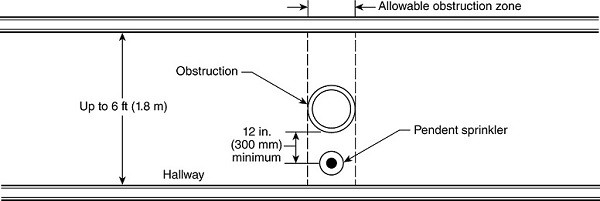
Handling bigger obstructions
In sprinkler placement, size matters. And NFPA 13 regards obstructions as getting pretty big when they reach 4 feet across. There are several rules addressing this scenario—two of the important ones are in the section dedicated to ensuring sprinkler pattern development, and one is in the section that aims to ensure water reaches the hazard:
Ensuring sprinkler pattern development
As mentioned above, the various rules in section 10.2.7.2 aim to ensure nothing inhibits the sprinkler’s spray pattern. Two items pertaining to larger obstructions are:
- If the obstruction is 4 feet across or less, sprinklers can be placed on either side of it (10.2.7.2(2))
- If the obstruction is over 4 feet wide, a sprinkler must be installed underneath it (10.2.7.2(6))
Ensuring water reaches the hazard
Section 10.2.7.4 covers “Obstructions that Prevent Sprinkler Discharge from Reaching Hazard” instead of those that disrupt the spray pattern. This subsection is within it:
10.2.7.4.2* Sprinklers shall be installed under fixed obstructions over 4 ft (1.2 m) wide.
So, all these directives are pretty simple. If an object is very big (over 4 feet wide), the sprinkler must be placed under it so water can get to the hazard.
And here is a good general rule of thumb: if an obstruction is 18 inches or more below the sprinkler deflector and is up to and including 4 feet wide, it can be ignored.
Ceiling fans
Ceiling fans’ blades make their dimensions pretty large, so sprinkler spacing around them might become difficult. But fortunately, NFPA 13 says you don’t always have to worry about them—you can ignore fan blades if:
- They are “less than 60 in. (1.5 m) in diameter.”
- Their plan view is “at least 50 percent open.” “Plan view” means viewed from above, as in an architectural drawing.
- The occupancy is light hazard (10.2.7.3.1.10).
However, the fan motor should be handled like any other obstruction. This means following either the three-times rule or the beam rule. Also, hazard levels above light hazard will need to apply additional rules to the blade dimensions—they still count as potential obstructions.
A step-by-step approach to the example: hospital smoke detectors & fire sprinkler head obstructions
So, given all that complex stuff above, what’s the answer to the question posed by a QRFS customer? Are the smoke/heat detectors placed near sprinklers a violation?
Here are the images again for reference:

Without knowing the exact measurements, the answer is “quite possibly.” Here is a step-by-step process assessing whether the detectors count as an obstruction:
1. First, can the smoke detector be an obstruction if it’s a nonstructural item?
Some fire protection stakeholders seem to assume the answer is no, at least with smaller objects in light and ordinary hazard occupancies. Sometimes, this may be due to confusion stemming from the language in the appendix and main section outlining the three-times rule, which says, “structural members only shall be considered.”
But the “enhanced content” commentary clarifies things (emphasis added):
The language in A.10.2.7.3.1.4 does not permit the use of nonstructural elements, including fixtures, and architectural features or treatments that would conceal, obscure, or otherwise obstruct sprinkler discharge. While the intent of 10.2.7.3.1.4 is to exempt nonstructural elements from meeting the Three Times Rule, the requirements of 10.2.7.2 and 10.2.7.4.2 still apply and must always be met.
In addition, remember section 9.1.1(3). This overarching approach stipulates that sprinklers’ positioning must “provide satisfactory performance with respect to […] distribution.”
So, yes: the smoke detectors in a light hazard hospital should be evaluated as potential obstructions subject to specific distance requirements.
2. Now, let’s attempt to use the three-times rule (10.2.7.3.1.3*):
Remember, it says that sprinklers must be spaced away from an obstruction at a distance of at least three times the object’s maximum dimension (its height or width, whichever is greater) up to 24 inches away (at which point you would not need to worry about the object).
A. Are the detectors 24+ inches away? If so, they aren’t an obstruction. But we can assume they weren’t that far away based on the inspector saying they were within 18 inches.
B. We would now have to measure the diameter of the smoke detector—but we can tell that the distance between the detector and the sprinkler is not three times that diameter. So, the three-times rule won’t work to say it’s not an obstruction.
3. Next, we go to the beam rule (10.2.7.2), referencing Table 10.2.7.2(a)
Again, the closer the smoke detector is to the sprinkler, the lower the sprinkler’s deflector needs to be relative to the bottom of the smoke detector to achieve clearance. Here’s that table again:
| Distance from Sprinklers to Side of Obstruction (A) (ft) | Maximum Allowable Distance of Deflector Above Bottom of Obstruction (B) [in.] |
|---|---|
| Less than 1′ | 0 |
| 1′ or more | 2-1⁄2″ or less |
| 1-1⁄2′ or more | 3-1⁄2″ or less |
| 2′ or more | 5-1⁄2″ or less |
| 2-1⁄2′ or more | 7-1⁄2″ or less |
| 3′ or more | 9-1⁄2″ or less |
| 3-1⁄2′ or more | 12″ or less |
| 4′ or more | 14″ or less |
| 4-1⁄2′ or more | 16-1⁄2″ or less |
| 5′ or more | 18″ or less |
| 5-1⁄2′ or more | 20″ or less |
| 6′ or more | 24″ or less |
| 6-1⁄2′ or more | 30″ or less |
| 7′ or more | 35″ or less |
Continuing our example where the sprinkler is not at least 24 inches away from the smoke detector, let’s say it’s between 1 foot and 1-1/2 feet away (like 16 inches) away. Using that general measurement and looking at the table above shows that the sprinkler’s deflector must be 2-1/2 inches or less above the bottom of the smoke detector.
In the pictures of our example, the sprinkler in the top image might meet that threshold—its deflector could be fewer than 2-1/2 inches above the bottom of the smoke detector.
But, simply eyeballing things, it’s less likely that the sprinkler’s deflector in the bottom image is that low relative to the bottom of the smoke detector. In either case, you need an exact measurement to be sure—but one or both may be obstructions.
4. What about the exception for smaller hallways (10.2.7.3.1.10)?
Remember, these rules governing small objects don’t matter if a hallway is less than 6 feet wide and the object is less than 12 inches across. Again, we don’t know the precise measurements. But many hallways in treatment areas of hospitals are 8 feet wide or greater to accommodate equipment while meeting the rules in NFPA 101 (2021: 19.2.3.4*) and other codes and industry standards.
Thus, between the detector’s possible diameter and the hallway’s width, there’s a good chance the small-hallway exception won’t work. And for obvious reasons, the rules we’ve mentioned earlier governing ceiling fans, larger objects of 4 feet+, and obstructions against walls don’t apply in this example.

The verdict on whether those smoke detectors are fire sprinkler head obstructions:
Once again—we need exact measurements. But it’s quite possible those smoke detectors in the hospital count as obstructions.
In addition, let’s restate an important concept: authorities having jurisdiction (AHJs) have some discretion about enforcing the rules that’s granted by section 9.1.1(3) of NFPA 13. It’s because some objects might technically violate the rules but not impact “satisfactory [… water] distribution.” Or other items sometimes technically follow the obstruction distance rules but will still block a sprinkler’s spray pattern development or prevent water from reaching its target.
Thus, if an AHJ believes a given item and its position will or will not result in “satisfactory performance,” they can exercise discretion—which can work for or against the building owner or designated representative responsible for the sprinkler system.
Nevertheless, in most cases and for most objects, the distance rules ensure you and your sprinklers are in the clear.
Fire sprinkler obstructions can be avoided with careful planning
Various objects can create problems for fire sprinklers and their water distribution, but following the rules closely can sidestep these issues.
Careful placement enables water to spray under, around, or on either side of objects. Planners can accomplish this objective for smaller objects by keeping obstructions away (horizontally) from sprinklers and/or making sure closer objects are more level with the sprinkler’s deflector (rather than significantly below it). In other cases, multiple sprinklers may be necessary to ensure adequate coverage.
Thoughts on Fire is your resource for understanding fire protection equipment, codes, and standards. For more on sprinkler spacing and obstruction, see our past entries on standard coverage sprinkler spacing, standard coverage obstructions, extended coverage sprinkler spacing, and extended coverage obstructions.
If you need fire sprinklers, check out our huge selection. You can also use the QRFS Quick Finder to identify the specific sprinklers, covers, escutcheons, or wrenches you need.
This blog was originally posted at blog.qrfs.com. If this article helped you, check us out at Facebook.com/QuickResponseFireSupply or on Twitter @QuickResponseFS.


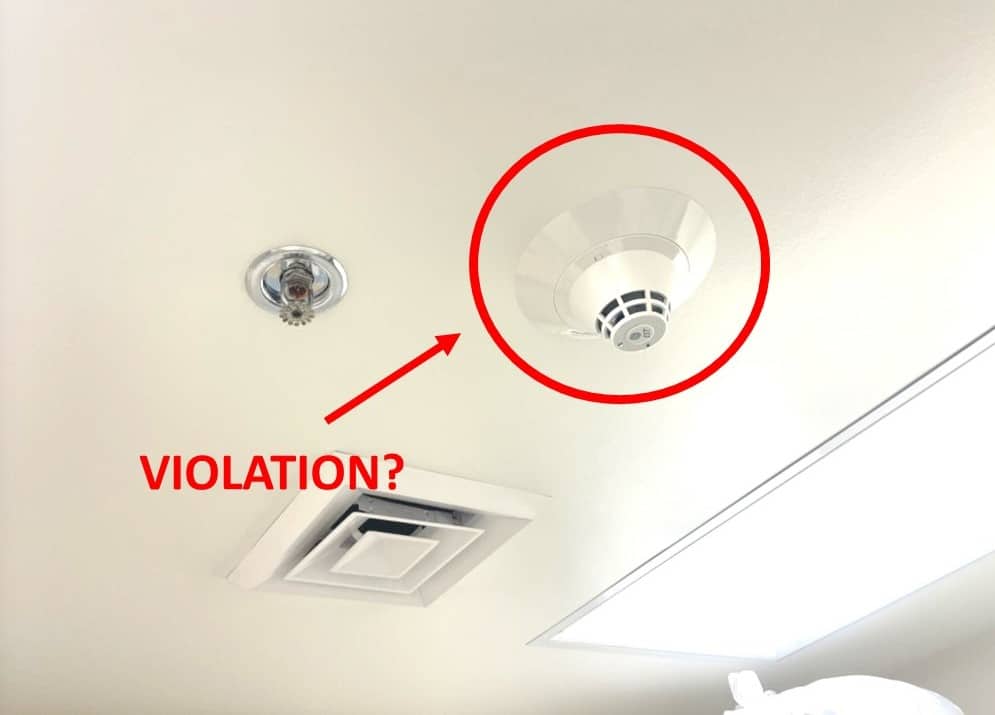
This rule makes no sense! It’s only an obstruction if it’s structural. The water doesn’t care if it hits a structure or something non-load bearing like a pipe or a duct. It’s completely arbitrary.
It’s like saying, “it’s not an obstruction if you install it on a Thursday”.
Ben — By your comment, we believe you are referring to the “three-times rule:” “NFPA 13 states that in light and ordinary hazard occupancies, ‘structural members only shall be considered” when using it (10.2.7.3.1.4).'” Without debating whether these rules are somewhat confusing (you’d certainly win that debate!), the standard does point to other rules to use instead in these situations that effectively accomplish the same goal. Here’s more language from the Annex:
“However, the other obstruction rules, including the “Beam Rule” (see 10.2.7.2) and the “Wide Obstruction Rule” (see 10.2.7.4.2), still apply. If an obstruction is so close to a sprinkler that water cannot spray on both sides, it is effectively a continuous obstruction as far as the sprinkler is concerned and the Beam Rule should be applied.
It is not the intent of this section to permit the use of fixtures and architectural features or treatments to conceal, obscure, or otherwise obstruct sprinkler discharge. The requirement should be applied in accordance with the performance objectives in 10.2.7.1.”
So “an obstruction is so close to a sprinkler that water cannot spray on both sides”. Would this include a smoke detector? You don’t seem to want to speculate. That guidance doesn’t clarify much because a sprinkler can’t spray both sides of any object simultaneously.
The Beam Rule only seems to apply to elements on the underside of a ceiling. If you look at FIGURE 10.2.7.2(a) it’s difficult to make a case that the beam rule is supposed to apply to elements that aren’t on the underside of a ceiling (would you want to tell a contractor that it does?). What if there is no suspended ceiling? In this case, the code seems to say any obstruction is fine provided it’s less that 4′ (1.2m) wide and provided it’s not load bearing.
Ben — “That guidance doesn’t clarify much because a sprinkler can’t spray both sides of any object simultaneously.” A sprinkler can spray on both sides of an object simultaneously if it has enough clearance to do it (what that passage intends to describe; something that does not obstruct its spray pattern). Otherwise, this article was written in consultation with an NFPA committee member and AHJ to attempt clarification of a confusing situation and the rules in the example above (a smoke detector on the ceiling of a medical facility). We will catalog your questions about elements not on the ceiling, etc., and may author a follow up with various scenarios and references. Thanks for reading and commenting!
If they consulted an AHJ, that would tend to explain why we have such a terrible rule.
Subjective rules are bad for every stakeholder except for the AHJ.
In that specific example of a hospital, it’s kind of late in the process after the ceiling is completed building finished, ready to employ staff and treat patients, but the AHJ decides we need to cut up the ceiling based on their subjective interpretation of the beam rule.
Ben — We agree with you — except noting that subjective rules aren’t always a benefit for AHJs. Sometimes, AHJs are legitimately confused about how to interpret some rules and unclear sections and would really like more clarity to make their job easier and more effective. But yes, there is sometimes too much confusion and variable enforcement, and the building owners and fire protection pros typically experience the consequences.
What about exit signs creating obstructions? I have always been guided towards the 18 inch code around a sprinkler deflector. However, using charts to determine the size of the exit sign provided in NFPA 13 and using the “three times rule” 24 inches, does push you more than 18 inches from a sprinkler deflector. Any guidance or code that can be referenced similarly to initiating devices, however, an exit sign would be very helpful.
Joshua — Unfortunately the rules and scenarios are a bit complex for us to dive into in this forum, other than pointing toward closely reviewing NFPA 13. If you would like a fire pro (an NFPA committee member and AHJ) to evaluate a specific situation, you can try our Ask a Fire Pro service for a well-researched answer. Thanks for reading!
The beam rule do not apply for a smoke detector, however a distance can maintain in between them of not less than 300 to 400mm.Cannot be less than this.
What is the minimum distance allowed below a sidewall fire sprinkler if I’m to add a cabinet below? Is it allowed? Where can I find allowable distance and/or obstruction below a sidewall fire sprinkler (HSW).
Matt — The minimum distance rules regarding sprinklers and obstructions are crucial and can be complex (the content of this blog is an example), and we don’t want to provide definitive guidance in this forum. Your best bet is to contact a local sprinkler pro, describe your situation and provide more specifics, and get specific guidance. Thanks for reading!
We have moved into an housing facility with side wall mounted sprinkler heads and have been told that framed pictures cannot be mounted within 18” of the heads. In that the heads protrude about 4” from the side walls, and the pictures protrude only 2”, I don’t see how this would interfere with the dispersal pattern. Is any clearance distance really needed?
“
Graig — Without knowing all the specifics of the building, etc., arguably the picture you describe may not interfere with pattern development. However, whomever is enforcing the rule is likely going by this reference (NFPA 13, 2025 edition):
Rationale: “”Most of the pattern development occurs within a zone beginning at the sprinkler deflector and extending 18 in. to 36 in. (450 mm to 900 mm) below the sprinkler.”
However, the authority having jurisdiction has the ultimate say on what is permitted.
If you’d like to investigate and perhaps make a case for picture and other obstruction positioning, check out Chapter 10 of NFPA 13 (2025 edition), section 10.3.6 Obstructions to Sprinkler Discharge (Standard Sidewall Spray Sprinklers). Much of this section focuses on ceiling obstructions, but subsection 10.3.6.1.4 deals with “Obstructions projecting from the same wall as the one on which the sidewall sprinkler is mounted.”
If you need it, NFPA allows access to free versions of the standards here. Thanks for reading!